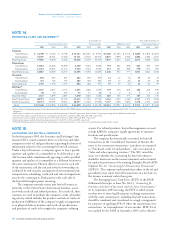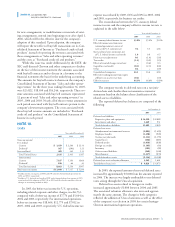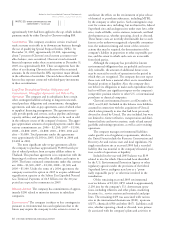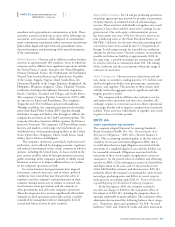Chevron 2005 Annual Report Download - page 76
Download and view the complete annual report
Please find page 76 of the 2005 Chevron annual report below. You can navigate through the pages in the report by either clicking on the pages listed below, or by using the keyword search tool below to find specific information within the annual report.
74 CHEVRON CORPORATION 2005 ANNUAL REPORT
Notes to the Consolidated Financial Statements
Millions of dollars, except per-share amounts
If either condition is not met, or if an enterprise obtains
information that raises substantial doubt about the eco-
nomic or operational viability of the project, the exploratory
well would be assumed to be impaired, and its costs, net of
any salvage value, would be charged to expense. The FSP
provides a number of indicators that can assist an entity to
demonstrate suffi cient progress is being made in assessing the
reserves and economic viability of the project.
The following table indicates the changes to the com-
pany’s suspended exploratory-well costs for the three years
ended December 31, 2005. No capitalized exploratory well
costs were charged to expense upon the adoption of FSP FAS
19-1. Amounts may differ from those previously disclosed
due to the requirements of FSP FAS 19-1 to exclude costs
suspended and expensed in the same annual period.
Year ended December 31
2005 2004 2003
Beginning balance at January 1 $ 671 $ 549 $ 478
Additions associated with the
acquisition of Unocal 317 – –
Additions to capitalized exploratory
well costs pending the
determination of proved reserves 290 252 344
Reclassifi cations to wells, facilities
and equipment based on the
determination of proved reserves (140) (64) (145)
Capitalized exploratory well costs
charged to expense (6) (66) (126)
Other reductions* (23) – (2)
Ending balance at December 31 $ 1,109 $ 671 $ 549
*Represent property sales and an exchange.
The following table provides an aging of capitalized well
costs and the number of projects for which exploratory well
costs have been capitalized for a period greater than one year
since the completion of drilling. The aging of the former
Unocal wells is based on the date the drilling was completed,
rather than Chevron’s August 2005 acquisition of Unocal.
Year ended December 31
2005 2004 2003
Exploratory well costs capitalized
for a period of one year or less $ 259 $ 222 $ 181
Exploratory well costs capitalized
for a period greater than one year 850 449 368
Balance at December 31 $ 1,109 $ 671 $ 549
Number of projects with exploratory
well costs that have been capitalized
for a period greater than one year* 40 22 22
* Certain projects have multiple wells or fi elds or both.
Of the $850 of exploratory well costs capitalized for a
period greater than one year at December 31, 2005, approxi-
mately $313 (20 projects) related to projects that had drilling
activities under way or fi rmly planned for the near future.
An additional $63 (four projects) had drilling activity dur-
ing 2005. The $474 balance related to 16 projects in areas
requiring a major capital expenditure before production
could begin and for which additional drilling efforts were not
under way or fi rmly planned for the near future. Additional
drilling was not deemed necessary because the presence of
hydrocarbons had already been established, and other activi-
ties were in process to enable a future decision on project
development.
The projects for the $474 referenced above had the fol-
lowing activities associated with assessing the reserves and
the projects’ economic viability: (a) $141 – additional seismic
interpretation planned, with front-end engineering and design
(FEED) expected to commence in 2007 (two projects); (b) $82
– evaluation of drilling results and pre-FEED studies ongoing
with FEED expected to commence in 2006 (one project);
(c) $74 – fi nalization of pre-unit agreement with operator
of adjacent fi eld and the progression of joint subsurface and
joint concept selection studies, with FEED expected to begin
in 2006 (one project); (d) $63 – FEED contracts executed in
2005 and continued marketing of equity natural gas (two proj-
ects); (e) $114 – miscellaneous activities for 10 projects with
smaller amounts suspended. While progress was being made
on all the projects in this category, the decision on the recog-
nition of proved reserves under SEC rules in some cases may
not occur for several years because of the complexity, scale and
negotiations connected with the projects. The majority of these
decisions are expected to occur in the next three years.
The $850 of suspended well costs capitalized for a period
greater than one year as of December 31, 2005, represents
105 exploratory wells in 40 projects. The tables below contain
the aging of these costs on a well and project basis:
Exploratory wells costs greater than one year:
Number
Aging based on drilling completion date of individual wells: Amount of wells
1994–2000 $ 147 28
2001–2004 703 77
Total $ 850 105
Number
Aging based on drilling completion date of last well in project: Amount of projects
1998–2000 $ 91 4
2001–2005 759 36
Total $ 850 40
NOTE 21.
EMPLOYEE BENEFIT PLANS
The company has defi ned-benefi t pension plans for many
employees. The company typically pre-funds defi ned-benefi t
plans as required by local regulations or in certain situa-
tions where pre-funding provides economic advantages. In
the United States, all qualifi ed tax-exempt plans are subject
to the Employee Retirement Income Security Act (ERISA)
minimum funding standard. The company does not typically
fund domestic nonqualifi ed tax-exempt pension plans that
are not subject to funding requirements under laws and regu-
lations because contributions to these pension plans may be
NOTE 20. ACCOUNTING FOR SUSPENDED
EXPLORATORY WELLS – Continued
























